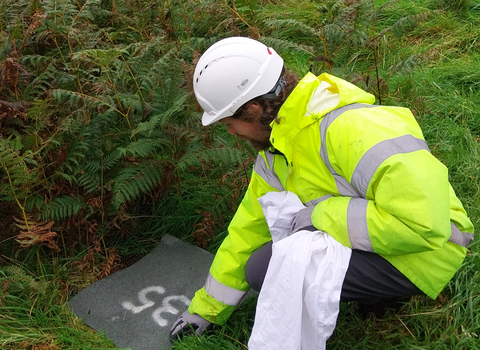Supporting biodiversity as part of the planning process
We were approached, in 2022, to carry out preliminary ecological surveys by Williams Homes (Bala) Ltd. for a development in Penrhyndeudraeth, Gwynedd. The development is a small housing estate of just over 40 affordable residences.
The area was a small field within the village, bordered by housing to the east and the main road to the south, with a line of mature trees forming the northern boundary and a dry-stone wall to the west.
The process
We carried out a Preliminary Ecological Appraisal (PEA) of the site in August 2022, which concluded that the area was a mix of slightly acidic grassland and bracken, with a small stream in the centre. The site was considered very suitable for reptile species. We also found Japanese knotweed present.
Natural Resources Wales (NRW) expressed concerns around scheme’s potential impact on bats using the tree line to the north.
We recommended a reptile survey be carried out. In September 2022, a full survey with over 100 artificial refugia found a population of slow worms was present across the site. As slow worms are protected under the Wildlife & Countryside Act (as amended) from intentional and reckless killing, preventative action was needed to allow the work to go ahead.
In dialogue with the local council ecologist, we decided that the slow worms would need to be relocated off site, as the best means of protecting them. We managed, in collaboration with the county ecologist and other stakeholders, to identify a suitable receptor site with no existing population, that would secure the individuals and allow them to start a new population in a safe area. We produced a reptile method statement for the scheme, setting this all out for the planning application.
Working with the client and a firm of lighting engineers, we were able to design a scheme using a combination of positioning, baffles, fences and vegetation, which provided dark corridors for bats so they would not be impacted by the development.
We provided advice on habitat design for the proposed scheme, including features for bats and reptiles, and preservation of the stream as a corridor across the site.
The knowledge of the team was invaluable when providing solutions to the challenges we faced, their prompt and thorough input meant that the scheme was built on schedule with all the necessary mitigation included.Williams Homes (Bala) Ltd
The outcome
Approximately 80 slow worms were relocated safely to the release site over the course of a month in 2023, by our team of staff and subcontractors. When we supervised the clearance of the site, carrying out a watching brief while the vegetation was removed from necessary areas of the site, no slow worms were in evidence indicating that the translocation had been successful.
Knotweed was treated and removed by specialist contractors after the reptile works were completed.
The scheme successfully went through planning and was built in 2023-24.
We work regularly with Enfys on schemes all across North Wales and have excellent service on all occasions; I cant recommend them highly enough.Williams Homes (Bala) Ltd

